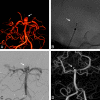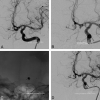Intrasaccular flow-disruption treatment of intracranial aneurysms: preliminary results of a multicenter clinical study
- PMID: 22678844
- PMCID: PMC7965497
- DOI: 10.3174/ajnr.A3191
Intrasaccular flow-disruption treatment of intracranial aneurysms: preliminary results of a multicenter clinical study
Abstract
Background and purpose: The endovascular treatment of intracranial aneurysms with unfavorable anatomy (large aneurysms, wide-neck) is frequently challenging and is also associated with a high incidence of significant recurrences. The WEB, an intrasaccular flow disrupter, was designed for use in this type of aneurysm. We report our early experience with this device in this multicenter study.
Materials and methods: Twenty patients with 21 aneurysms were treated by using the WEB in 3 European centers. The ability to successfully deploy the WEB, immediate posttreatment angiographic results, adverse events, clinical outcome, and angiographic follow-up results were recorded.
Results: Aneurysm location was the ICA (4/21, 19.1%), MCA (8/21, 38.1%), AcomA (5/21, 23.8%), and BA (4/21, 19.1%). No treatment failures were reported. Treatment was performed exclusively with the WEB in 16/21 (76.2%) patients. Additional treatment (coiling and/or stent placement) was used in 5/21 (23.8%) patients. One patient (4.8%) experienced transient clinical worsening (mRS 1 at 1 month, mRS 0 at 3 months) related to a thromboembolic event. Inadvertent detachment of the WEB was observed, and the WEB was retrieved in 1 patient, without adverse effects. In the short-term follow-up (2-8 months), adequate occlusion (total occlusion or neck remnant) was observed in 80.0% of aneurysms.
Conclusions: Intrasaccular flow disruption is a new endovascular approach for aneurysm treatment. In our preliminary experience, this treatment was feasible and mostly used in bifurcation aneurysms (MCA, BA, ICA) with unfavorable anatomy. Further studies are needed to precisely evaluate the indications, safety, and efficacy of this new technique.
Figures




References
-
- Molyneux A, Kerr R, Stratton I, et al. for the International Subarachnoid Aneurysm Trial (ISAT) Collaborative Group. International Subarachnoid Aneurysm Trial (ISAT) of neurosurgical clipping versus endovascular coiling in 2143 patients with ruptured intracranial aneurysms: a randomised trial. Lancet 2002;360:1262–63 - PubMed
-
- Cognard C, Pierot L, Anxionnat R, et al. for the Clarity Study group. Results of embolization used as the first treatment choice in a consecutive non selected population of ruptured aneurysms: clinical results of the Clarity GDC study. Neurosurgery 2011;69:837–41 - PubMed
-
- Pierot L, Spelle L, Vitry F. for the ATENA Investigators. Immediate clinical outcome of patients harboring unruptured intracranial aneurysms treated by endovascular approach: results of the ATENA trial. Stroke 2008;39:2497–504 - PubMed
-
- Ferns SP, Sprengers ME, von Rooij WJ, et al. . Coiling of intracranial aneurysms: a systematic review on initial occlusion and reopening and retreatment rates. Stroke 2009;40:e523–e29 - PubMed
-
- Pierot L, Spelle L, Leclerc C, et al. . Endovascular treatment of unruptured intracranial aneurysms: comparison of safety of remodeling technique and standard treatment with coils. Radiology 2009;251:846–55 - PubMed
Publication types
MeSH terms
LinkOut - more resources
Full Text Sources
Other Literature Sources
Medical
Miscellaneous
